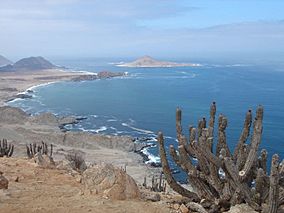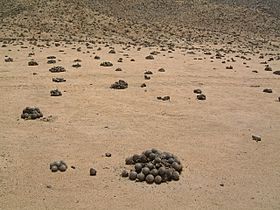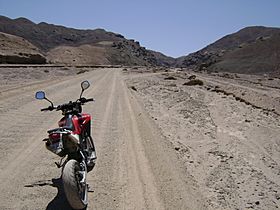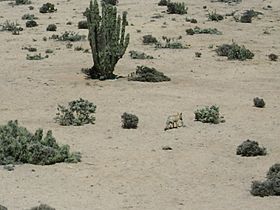Pan de Azúcar National Park facts for kids
Quick facts for kids Pan de Azúcar National Park |
|
|---|---|
|
IUCN Category II (National Park)
|
|
 |
|

Pan de Azúcar Region
|
|
| Location | Antofagasta Region-Atacama Region, Chile |
| Nearest city | Chañaral |
| Area | 438 km2 (169 sq mi) |
| Established | 1985 |
| Governing body | Corporación Nacional Forestal |
Pan de Azúcar National Park is a special nature area in Chile. It sits right on the border between the Antofagasta Region and the Atacama Region. Its name, Parque Nacional Pan de Azúcar, means "Sugar Loaf National Park" in Spanish. This park is a great place to see unique plants and animals that have adapted to the desert.
Contents
Exploring Pan de Azúcar National Park
This park is about 30 kilometers (18 miles) north of Chañaral. It is also 180 kilometers (112 miles) north of Copiapó. The park was created in 1985 to protect its amazing wildlife. It covers a large area of about 438 square kilometers (169 square miles). This includes a small part of islands. The park is important because it has many different kinds of plants and animals.
Isla Pan de Azúcar: Home to Penguins
Just 24 kilometers (15 miles) from the mainland is Isla Pan de Azúcar. This island is a breeding ground for Humboldt penguins. These special penguins raise their young here. You can visit the island by boat from the mainland. However, visitors must stay on the boat to protect the penguins.
Caleta Pan de Azúcar: A Coastal Village
Caleta Pan de Azúcar is a small fishing village. It is now a popular spot for tourists. Long ago, people used to mine copper here. The copper was then shipped out by boat. Today, divers can still explore parts of the old wharf and loading crane underwater. From this cove, you can drive about 8 kilometers (5 miles) to a lookout point called Mirador. From here, you can see animals living on the mountain slopes. They survive thanks to the coastal mist.
Road North of Caleta Pan de Azúcar
North of the cove, there is a gravel road. This road connects to the main Pan-American Highway. Along this road, you can see many interesting rock formations. These formations show how the land has changed over time.
Wildlife and Ecosystems
Pan de Azúcar National Park has two main types of natural areas. These are the coastal desert of Taltal and the steppe desert of the Sierra Vicuña Mackenna. It does not rain much here. But the plants and animals get water from a special coastal mist. This mist is called Camanchaca by local people.
Amazing Desert Plants
The park is home to more than 20 types of cactus. Most of these belong to the Copiapoa group. You can see many of these cacti at the cactarium. This is a special garden for cacti. It is located at the CONAF environmental office. This office is near Los Piqueros Beach, about 8 kilometers (5 miles) from the park entrance. The cactarium is open every day for visitors.
Animals of Pan de Azúcar
The guanaco is a large mammal often seen in the park. It is related to llamas. Other mammals include the culpeo fox and the chilla fox. You might also spot the European hare.
Near the ocean, you can find marine mammals. These include the marine otter and the South American sea lion. Many birds live here too. The Humboldt penguin and the Peruvian pelican are two examples. The park also has different types of reptiles. These include lizards from the Tropidurus and Callopistes groups.
-
A chilla fox in the park
See also
 In Spanish: Parque nacional Pan de Azúcar para niños
In Spanish: Parque nacional Pan de Azúcar para niños





